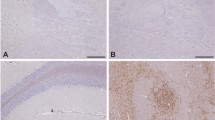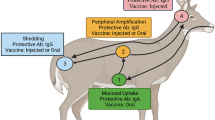Abstract
Ovine and caprine scrapie occupies a unique place among animal transmissive spongiform encephalopathies (TSE). It is an object of intensive biomedicinal, ecological and economical studies. Its causative agents are demonstrably associated with the development of TSE in farmed minks, goats and moufflons. Ovine strains of scrapie occurring in North America (particularly in the USA) differ from strains which occur in Europe and were present at the onset of development of TSE in three species of deer living in free nature and in captivity in the USA. The studies dealing with the development of bovine spongiform encephalopathy (BSE) of the English type have indicated justifiably that its origin is associated with one (or more) heretofore unidentified ovine strain. The development of a variant form, the Creutzfeldt-Jacob disease in humans, and transmission of the BSE agent to several families of bovidae, felidae and primates, puts stress on its zoonotic potential. All this leads to the conclusion that domesticated sheep are the decisive reservoir species of animal TSE. They have been infected to an unknown extent with the causative agent of BSE probably through contaminated meat-bone meal. The occurrence of natural ovine prion isolates with properties similar to those of the BSE agent requires that scrapie should be included in the surveillance of human and animal TSE. At present, scrapie is a noticeable disease also in other thanEuropean Communities Member States. It is on the list B of theInternational Epizootics Office. Many countries have initiated control of ovine scrapie. It should therefore become a topical question also in Central and Eastern European countries. Elimination or even eradication of ovine scrapie (or its causative agents) from populations of small and large domestic ruminants is the prerequisite for prevention of penetration of ovine pathogenic prions into the human feed chain. Moreover, it should be ensured that these species will be able to produce foods of a new type (immunotrition and similar) or proteins with therapeutic effects in the near future. Our study established that the PrP genotype of Valachian rams, the Slovak autochthonous breed, contains also VRQ and ARQ alleles encoding the susceptibility to scrapie. Their selection is part of the improvement of Slovak Valachian sheep towards resistance to scrapie.
Similar content being viewed by others
Abbreviations
- BSE:
-
bovine spongiform encephalopathy
- CJD:
-
Creutzfeldt-Jakob disease
- nvCJD:
-
new variant of Creutzfeldt-Jakob disease
- FAO:
-
Food and Agricultural Organization
- M142 :
-
Met at codon 142 of the PrP gene
- OTSE:
-
ovine TSE
- PrP:
-
infectious protein particle
- PrPSc :
-
scrapie PrP, or protein-resistant form of PrP
- TME:
-
TSE of mink
- TSE:
-
transmissible spongiform encephalopathy
References
Baron T.G.M., Madec J.A., Caavas D.: Similar signature of the prion protein in natural sheep scrapie and bovine spongiform encephalopathy-linked diseases.J. Clin. Microbiol. 11, 3701–3704 (1999).
Belt P.B.G.M., Muileman I.H., Schreuder B.E.C., Bos-de Ruijter J., Gielkens A.L.J., Smits M.A.: Identification of five allelic variants of the sheep PrP gene and their association with natural scrapie.J. Gen. Virol. 76, 509–517 (1995).
Bossers A., de Vries R., Smits M.: Susceptibility of sheep for scrapie as assessed byin vitro conversion of nine naturally occurring variants of PrP.J. Virol. 74, 1407–1414 (2000).
Bruce M.E.: Strain typing studies of scrapie and BSE, pp. 223–236 in H. Bakter, R.M. Ridley:Prion Diseases. Humana Press, Totowa 1996.
Carr R.I., Meeker H., Sersen E.: Scrapie strains retain their distinctive characteristics following passages of homogenates from different brain regions and spleen.J. Gen. Virol. 78, 283–290 (1997).
Carp R.I., Callahan S.M.: Variation in the characteristics of 10 mouse-passaged scrapie lines derived from five scrapie-positive sheep.J. Gen. Virol. 72, 293–298 (1991).
Černík J., Jurák E., Štepánek E., Šmíd J., Lavička B., Čermák S.: Validation of the occurrence of scrapie in the Czech Republic, pp. 1–2 inBovine Spongioform Encephalopathy and Other Human and Animal Spongioform Encephalopathies (READY), Košice 1992.
Collinge J., Sidle K.C.L., Meads J., Ironside J., Hill A.F.: Molecular analysis of prion strain variation and the etiology of “new variant” CJD.Nature 383, 685–690 (1996).
Cuille J., Chelle P.L.: La maladie dite tremblante du mouton est-elle inoculable?C. R. Acad. Sci. Paris 203, 1552–1554 (1936).
Dawson M., Hoinvilla L.J., Hosie B.D., Hunter N.: Guidance on the use of genotyping as an aid to the control of clinical scrapie.Vet. Res. 142, 623–625 (1998).
European Commission: Preliminary Report on the Evaluation of Test for the Diagnosis of Transmissible Spongioform Encephalopathy in Bovines, p. 1–36 inNatural Scrapie in Sheep and Goats, Annex 2. European Commission, Brussels 1999.
Fraser H.: A survey of primary transmission of Icelandic scrapie (rida) to mice, pp. 34–46 inVirus Non Conventionnels et Affections du Système Nerveux Central. Masson, Paris 1983.
Goldmann W., Martin T., Hughe S., Smith G., Hughes K., Dawson N., Hunter N.: Novel polymorphism in the caprine PrP gene: a codon 142 mutation associated with scrapie incubation period.J. Gen. Virol. 77, 2885–2891 (1996).
Griffith J.S.: Self-replication and scrapie.Nature 215, 1043–1044 (1967).
Hadlow W.J.: Reflection on the transmissible spongiform encephalopathies.Vet. Pathol. 36, 523–529 (1999).
Hope J., Wood S.C.E.R., Birkett C.R., Chong A., Bruce M.E., Cairns D., Goldmann W., Hunter N., Bostock C.J.: Molecular analysis of ovine prion protein identified similarities between BSE and an experimental isolate of natural scrapie.J. Gen. Virol. 80, 1–4 (1999).
Van Keulen L.J.M., Schreuder B.E.C., Vromans M.E.W., Langveld L.P.M., Smits M.A.: Scrapie-associated prion protein in the gastrointestinal tract of sheep with natural scrapie.J. Comp. Pathol. 121, 55–63 (1999).
Laplanche J.L., Hunter N., Shinagawa M., Williams E.: Scrapie: chronic wasting disease and transmissible mink encephalopathy, pp. 393–426 in S.B. Prusiner.Prion Biology nad Diseases. Cold Spring Harbor Laboratory Press, New York 1999.
MacKenzie D.: BSE in American sheep? It's far-fetched speculation say experts.New Scientist 167, 5 (2000)
Mitrová E., Hunčaga S., Hocman G., Nyitrayová O., Tatara M.: “Clusters” of CJD in Slovakia: the first laboratory evidence of scrapie.Eur. J. Epidemiol. 5, 520–524 (1991).
Murphy F.A., Paul E., Gibbs J., Horzinek M.C., Studdert J.:Veterinary Virology, 3rd ed., pp. 571–580. Academic Press, San Diego-London 1999.
Paraf A.: Scrapie and bovine spongiform encephalopathy immunological properties and diagnosis for food products.Lait 76, 571–578 (1996).
Prusiner S.B.: Novel proteinaceous infectious particles cause scrapie.Science 216, 136–144 (1982).
Secondary Guidelines to Development of National Farm Animal Genetic Resources Management Plans, Vol. 1998, p. 11. Food and Agriculture Organization of the United Nations, New York 1999.
Smits M.A., Bossers A., Schreuder B.E.C.: Prion protein and scrapie susceptibility.Vet. Quart. 19, 101–105 (1997).
Zeidler M., Ironside J.W.: The new variant of Creutzfeld-Jakob diseases.Rev. Sci. Tech. Office Internat. Epizool. 98, 98–120 (2000).
Author information
Authors and Affiliations
Rights and permissions
About this article
Cite this article
Novák, M., Vrtiak, O.J., Mikula, I. et al. Ovine scrapie: Priorities and importance. Folia Microbiol 45, 475–483 (2000). https://doi.org/10.1007/BF02818713
Received:
Issue Date:
DOI: https://doi.org/10.1007/BF02818713




